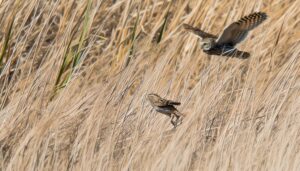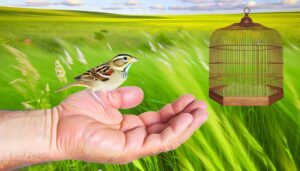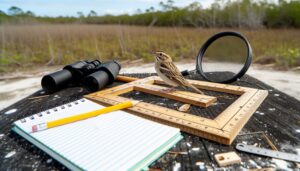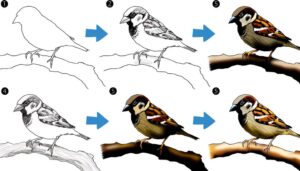How Does Belding’s Savannah Sparrows Catch Its Prey?
Belding's Savannah Sparrow uses various techniques to catch prey. It's adept at ground level foraging and pouncing from perches, often rushing its prey unexpectedly.
Its superior vision and fast flight, reaching up to 45 mph, enhance its hunting ability. Equipped with a sharp, pointed beak, it efficiently captures and consumes insects and small invertebrates, favoring beetles, caterpillars, and spiders.
Its diet varies based on seasonal availability. Learning more about this bird's physical characteristics, lifestyle, and interactions with other species offers a thorough understanding of its successful predation strategy.
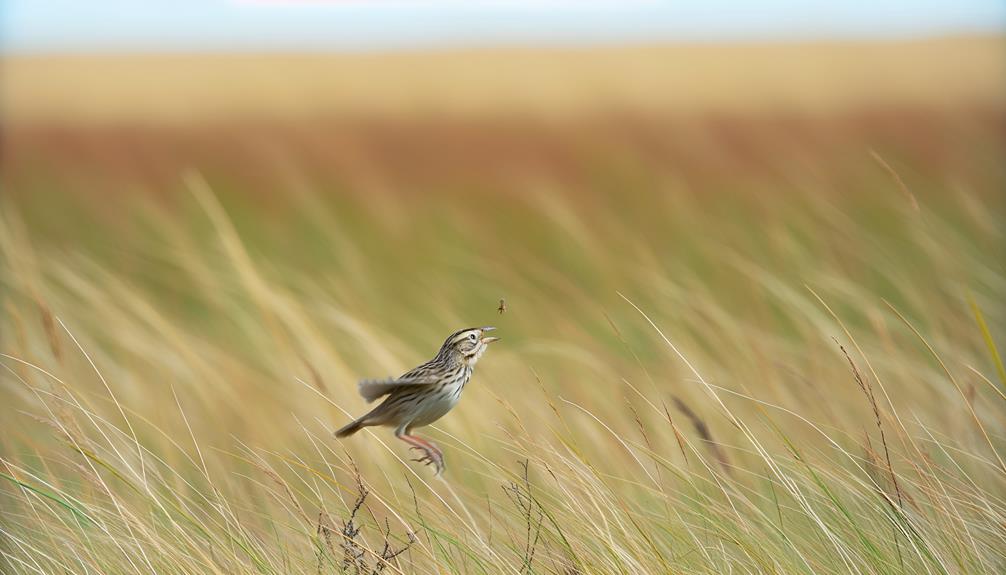
Key Takeaways
- Belding's Savannah Sparrows use various hunting techniques such as foraging on ground level and pouncing from perches.
- They employ stealth, surprise, and camouflage to catch prey unawares, rushing at them for a varied diet.
- Their physical features, including superior vision, sharp beaks, and high flight speed, aid efficient predation.
- Their diet mainly consists of insects and small invertebrates like beetles, caterpillars, spiders, and soft-bodied arthropods, caught using their adept hunting skills.
- The sparrows' speed, precision, and adaptability are vital for successful prey capture and evasion of predators.
Understanding Belding's Savannah Sparrows
To fully grasp the predatory behaviors of Belding's Savannah Sparrows, one must first understand this bird's unique characteristics and environments.
This species, scientifically known as Passerculus sandwichensis beldingi, is a small, insectivorous bird. It's recognized by its streaked brown plumage, pale underparts, and yellowish eyebrow. Their vocalization, a soft, buzzing song, is a key part of their hunting and communication strategies.
They're highly adaptive creatures, capable of adjusting their feeding habits based on prey availability. While their diet mainly consists of insects, in some cases, they've been observed feeding on seeds. This adaptability, combined with their sharp vision and swift flight, makes them effective predators.
Understanding these traits is vital to comprehending their predatory behaviors.
Sparrow's Habitat and Environment
The natural habitat of the Savannah Sparrow, particularly the Belding's subspecies, provides a pivotal framework for understanding its predatory behaviors.
Environmental changes, ranging from subtle shifts in climate to drastic habitat alterations, can impact their feeding habits and patterns.
Concurrently, the sparrow's adaptability to these changes will be explored, illuminating the species' resilience and survival strategies.
Savannah Sparrow's Natural Habitat
Nestled within the grasslands and marshes, Belding's Savannah Sparrows have carved out a natural habitat that perfectly suits their unique needs and behaviors. These birds prefer open habitats with low vegetation for easy access to ground-dwelling insects. Their environment is typically characterized by a mixture of grasses and shrubs, providing both food sources and nesting materials.
To better understand the habitat preferences of these sparrows, consider the following table:
| Environment | Purpose | Examples |
|---|---|---|
| Grasslands | Hunting and foraging | Grasshoppers, beetles |
| Marshes | Nesting and protection | Dense vegetation, wetlands |
| Shrubs | Food and nesting materials | Seeds, twigs, leaves |
| Low vegetation | Easy access to prey | Ground-dwelling insects |
| Mixed habitats | Increased survival chances | Grasslands + Marshes |
Understanding these details can provide valuable insights into the lives of the Belding's Savannah Sparrows.
Impact of Environmental Changes
As environmental changes continue to reshape habitats globally, Belding's Savannah Sparrows face significant shifts in their natural surroundings that can dramatically alter their survival and reproduction patterns.
Increased temperatures, for instance, can lead to a scarcity of their primary food source, insects, profoundly impacting their feeding habits.
Additionally, changes in precipitation patterns can alter the vegetation structure of their habitats, affecting their nesting sites.
Rising sea levels, particularly in their coastal habitats, can result in habitat loss. These changes not only affect the Sparrows' prey capture strategies but also their overall population health.
Hence, understanding the impact of environmental alterations on these sparrows is paramount for their conservation and the preservation of biodiversity.
Adaptations for Survival
Despite facing the challenges of shifting environmental conditions, Belding's Savannah Sparrows have evolved a variety of survival adaptations that help them thrive in their diverse habitats.
They've developed a cryptic plumage that blends seamlessly with the grasslands, effectively camouflaging them from predators.
In addition, their slender, conical beaks are perfectly shaped for catching insects, their primary food source.
These sparrows also exhibit an adaptive behavior known as 'mobbing', where they collectively harass potential predators to drive them away.
Moreover, they've adapted to a nomadic lifestyle, migrating seasonally to exploit resources in different environments.
These physical and behavioral traits are a proof of their resilience and adaptability, ensuring their survival in a dynamic world.
Physical Features Aiding Predation
Belding's Savannah Sparrows exhibit several physical characteristics that enhance their predatory abilities.
The precision and sharpness inherent in their vision play an important role in locating and identifying prey, while their sharp beaks provide an essential tool for capturing and consuming their targets.
The sparrow's flight speed, in addition, contributes to its ability to chase down and secure prey swiftly and efficiently.
Sparrows Vision and Accuracy
Equipped with superior vision, Savannah Sparrows exhibit remarkable accuracy in spotting and swooping down on their prey, a feature that greatly enhances their predatory efficiency. Their eyes, positioned on the sides of their heads, provide a wide field of view essential for detecting movement. This binocular vision allows for precise depth perception, necessary in judging distance when hunting.
The keenness of their eyesight is further amplified by a high density of cone cells in the retina, facilitating detailed color perception even in dim light. This allows them to discern small variations in color and movement, which are indicative of potential prey.
Consequently, the visual prowess of Savannah Sparrows, coupled with their precision and speed, make them formidable predators in their environment.
Sharp Beak Advantages
In addition to their exceptional vision, Savannah Sparrows utilize their sharp, pointed beaks as potent tools in their predatory arsenal. These beaks, perfectly adapted for a carnivorous diet, allow them to efficiently capture and consume a wide variety of insects.
Their unique curvature and pointed tips enable precise strikes, reducing the chances of prey escaping. Moreover, the robust structure provides necessary strength for dealing with resilient insects. The beak's sharpness aids in tearing apart food, making digestion more manageable.
Interestingly, the beak's shape also facilitates the handling of small, nimble prey, showcasing its versatility. Hence, it's evident that the sharp beak of the Savannah Sparrow plays a crucial role in its successful predation strategy.
Flight Speed Factor
Another key adjustment that enhances the Savannah Sparrow's predatory prowess is its impressive flight speed.
This avian predator can reach speeds of up to 45 miles per hour, enabling it to swoop down on unsuspecting insects or smaller birds with remarkable agility and precision.
This high velocity, coupled with their exceptional maneuvering skills, makes them formidable hunters in their habitats.
The speed also aids in evading potential predators, ensuring their own survival.
The propulsion is achieved through a combination of its lightweight body, strong wing muscles, and aerodynamic form.
The rapid wingbeat frequency further enhances its speed.
Therefore, the flight speed is more than just a feature; it's a survival tool, essential to the Savannah Sparrow's predatory and evasion strategies.
Diet Preferences of Savannah Sparrows
Despite their petite size, Belding's Savannah Sparrows exhibit a robust appetite, mostly favoring a diet rich in insects and small invertebrates. They've a penchant for beetles, caterpillars, spiders, and other soft-bodied arthropods. Seed and plant materials, though constituting a smaller portion of their diet, still provide essential nutrients.
Their dietary preference is dictated by seasonality and availability, with a higher dependence on invertebrates during breeding and nesting periods when protein needs are high. Their broad dietary range is likely a key factor in their adaptability to diverse habitats, demonstrating an evolutionary advantage.
The dietary choices of these sparrows, while largely insectivorous, reveal a complex interplay between environmental factors, nutritional needs, and survival strategies.
The Hunting Techniques
Masterful hunters, Belding's Savannah Sparrows employ a variety of techniques to capture their prey, showcasing their adaptability and keen survival instincts. They're experts at foraging, often scouring ground level for insects and other small invertebrates. Using their sharp beaks and claws, they skillfully unearth their prey from hiding spots in grass or soil.
They also exhibit a technique known as 'pouncing,' where they swiftly descend from a perch to seize their prey. In addition to these, these sparrows also utilize a rushing method, charging at their prey to catch them off guard. This multi-pronged approach guarantees they've a varied diet, increasing their chances of finding food in different habitats and conditions, thereby improving their survival rate.
Role of Stealth and Surprise
In the intricate world of Belding's Savannah Sparrows, stealth and surprise play pivotal roles in successful predation. Mastering camouflage techniques, these birds effectively blend with their environment, becoming virtually invisible to unsuspecting prey.
The element of surprise further bolsters their hunting strategy, allowing them to strike rapidly and decisively, thereby increasing their chances of securing a meal.
Mastering Camouflage Techniques
Utilizing the art of camouflage, Belding's Savannah Sparrows expertly blend into their grassland habitats, enabling them to stealthily catch their prey unawares. Their muted brown and grey plumage perfectly mimics the coloration of the surrounding flora, rendering them almost invisible amongst the reeds and grasses.
This species particularly favors habitats that match their distinct feather pattern, enhancing their concealment. Their physical adaptation isn't their only asset; these sparrows also possess a behavior called 'freezing.' When potential threats are nearby, they'll cease all movement, further enhancing their disguise.
This mastery of camouflage is a complex interplay of physical attributes and behavioral adaptations, allowing these sparrows to effectively evade predators while surreptitiously stalking their prey.
Surprise Attack Strategy
Belding's Savannah Sparrows cleverly employ stealth and the element of surprise to catch their prey off guard, a strategy that greatly enhances their hunting success. They're specialists in utilizing their surroundings for concealment, staying silent and still until the opportune moment for attack.
Their prey, typically insects, are often oblivious to the lurking threat, making them easy targets. Upon sighting potential prey, the Sparrows launch a swift, surprise assault, leaving their prey with little to no chance of escape. This surprise attack strategy isn't only effective but also energy-efficient, minimizing the Sparrows' need for prolonged chases.
Therefore, through a calculated blend of stealth and surprise, the Belding's Savannah Sparrows demonstrate an optimized hunting technique exemplary of avian predation.
The Sparrow's Speed and Precision
With a speed that belies their small size, Belding's Savannah Sparrows exhibit remarkable precision when catching their prey. Their compact body structure, coupled with rapid wingbeats, allows them to achieve astonishing aerial velocities. This agility is additionally complemented by their keen eyesight, enabling them to spot and track prey from sizable distances, even amidst dense vegetation.
The Sparrow's beak serves as a potent tool in ensuring the accuracy of their strikes. Its narrow, pointed structure is perfectly suited to grasp and hold onto agile prey. Moreover, their swift reflexes and sharp talons contribute to their predatory precision. The combination of these attributes allows the Belding's Savannah Sparrows to successfully secure their meals, demonstrating an impressive balance of speed and precision.
Predation and Sparrow Survival
While the remarkable speed and precision of these sparrows are essential to catching prey, they're equally important for evading predators, a critical aspect of their survival strategy. Predation pressure on Belding's Savannah Sparrows is high, with threats including larger birds, small mammals, and reptiles.
The sparrows' agility allows them to perform quick, unpredictable movements, often confusing potential predators. In addition, their keen eyesight and acute hearing aid in early predator detection, providing precious seconds to escape. Moreover, they've mastered the art of hiding and using the environment to their advantage.
These survival strategies aren't innate; they're learned over time, honed by repeated exposure to danger. The harsh reality of predation shapes the life and behavior of these sparrows.
Challenges in Catching Prey
Despite their adept hunting skills, Belding's Savannah Sparrows face considerable challenges in catching prey, primarily due to the small size and swift movements of their preferred food source—insects. These obstacles can be categorized into three main areas:
- Size disparity: The small size of insects makes them difficult targets. They can easily hide in foliage and evade detection.
- Speed and agility: Insects, particularly flying ones, can execute rapid directional changes, leaving the sparrow little time to react.
- Environmental factors: Weather conditions such as wind and rain can impair the sparrow's visibility and mobility, making successful hunting more challenging.
These factors not only affect the sparrow's ability to secure food but also its survival in a competitive ecosystem.
Adaptations to Improve Hunting
To counteract these hunting challenges, Belding's Savannah Sparrows have evolved a set of remarkable adjustments that optimize their insect-catching capabilities. They've developed a keen eyesight that allows them to spot even the smallest insects from significant distances.
Their beaks, small and pointed, are perfect for picking insects off leaves or from the ground. They've also developed quick reflexes, which are essential in nabbing fast-moving prey. The structure of their feet and claws allows them to grip onto branches and grass stems tightly, maintaining balance during hunts.
Moreover, their feathers have evolved to provide excellent camouflage, allowing them to blend in with their grassland habitats and approach prey undetected. These adaptations not only enhance their hunting skills but also secure their survival in a competitive food chain.
Interaction With Other Species
In the bustling ecosystem of their grassland habitats, Belding's Savannah Sparrows interact with a wide array of species, each relationship playing an essential role in their survival and propagation.
These interactions often revolve around three main aspects:
- Predation: Belding's sparrows, as small-sized birds, often become prey for larger birds and mammals.
- Competition: They compete with other seed-eating bird species for food resources, particularly during harsh winters.
- Mutualism: These sparrows also partake in mutualistic relationships with certain plant species, dispersing their seeds in return for food.
Such relationships not only shape the sparrow's behavior and adaptations but also influence the overall biodiversity and function of grassland ecosystems.
Understanding these interactions provides vital insights into the complex nature of ecological communities.
Conclusion
In the domain of nature, the Belding's Savannah Sparrow is a maestro conducting a symphony of survival. Its sharp beak, keen eyes, and nimble body are the instruments it plays to catch its prey.
Despite challenges, this sparrow has adapted, evolving its hunting techniques to guarantee its survival. Its interaction with other species is a dance of coexistence, highlighting the interconnectedness in the grand theatre of the ecosystem.
Truly, this sparrow's predation is a fascinating spectacle in nature's opera.


